
Author: Larry Jordan
Where Did All The Hummingbirds Go?
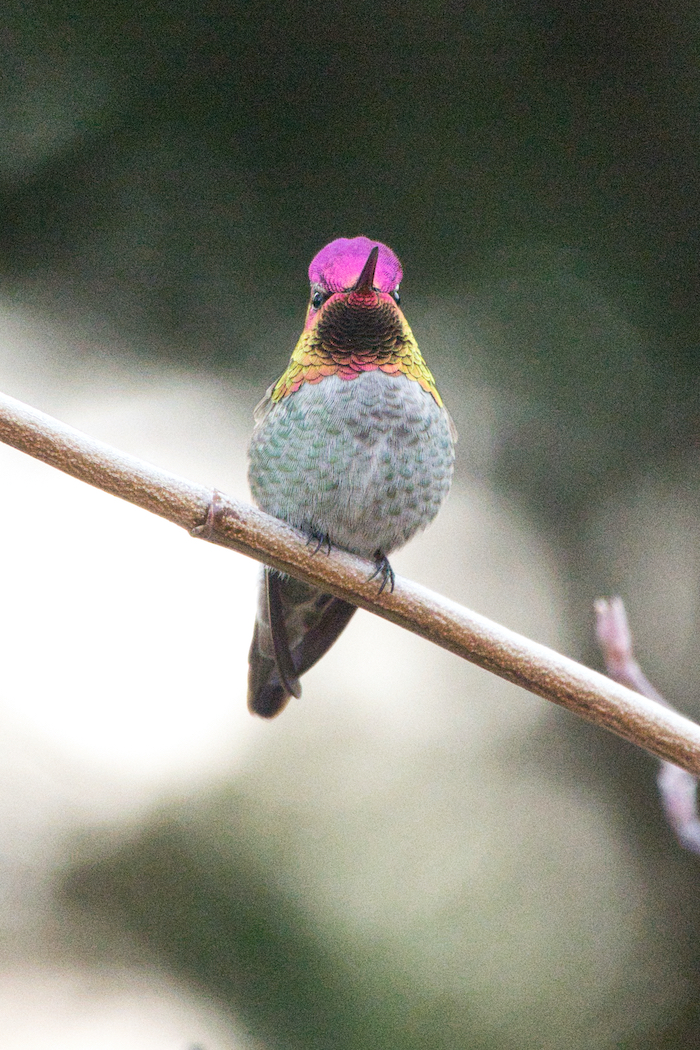
I was mixing gallons of sugar water with Anna’s Hummingbirds sucking it up as fast as I could make it just a few weeks ago. Where did they all go?

They went back to nature!

The local Manzanitas are blooming this time of year and, of course, the hummers prefer the real thing to sugar water.

During the spring and summer months, there are many native plants offering food for hungry hummers. Here are just a few.
California Thistle (Cirsium occidentale)

Red Yucca (Hesperaloe parviflora)
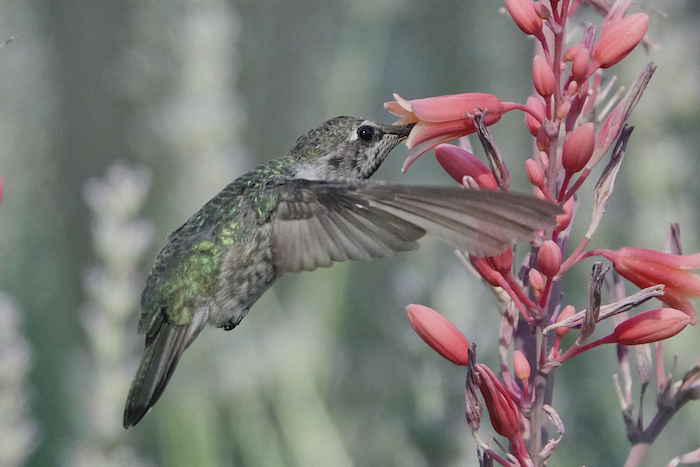
Autumn Sage (Salvia greggii)

Hummingbird Sage (Salvia spathacea)

and my favorite, Woolly Blue Curls (Trichostema lanatum)

You may have noticed a few other behaviors regarding the Anna’s Hummingbirds. In April, I had several instances of females landing in my graveled driveway and apparently consuming small particles of sand or other minerals from the gravel. According to Cornell’s “Birds of the World,” they are probably acquiring minerals for egg laying.

Getting back to the present, if you are lucky, you might find female Anna’s Hummingbirds gathering nesting material now, maybe in your yard or while out on a bird walk.

You can also provide natural cotton nesting material for them yourself, available at several outlets.

Again from Cornell Lab on the nest building. The inner cup is lined loosely with downy material (plant, feathers, hair). The walls are made of downy material including cattail (Typha), willow, underside of sycamore leaves, thistle, eucalyptus flowers, velvet groundsel (Senecio petasites), and small feathers. Binding materials are mostly spider webs and insect cocoon fibers, but also fibrous plant material and rodent hairs. Usually ornamented on the outside with bits of lichens, mosses, and dead leaves; occasionally bark, algae (Protococcus) or other plant materials, and paint chips. Nest materials are often stolen from another hummingbird’s nest. This is what the completed nest looks like, found at Turtle Bay Arboretum

Obviously, if female hummers are gathering nesting material, it’s breeding time! Just last Saturday, on our outing to Lema Ranch, we observed the male’s incredible mating flight! This video is incredible! Isn’t nature amazing?
It’s Time to Clean Out Your Nest Boxes
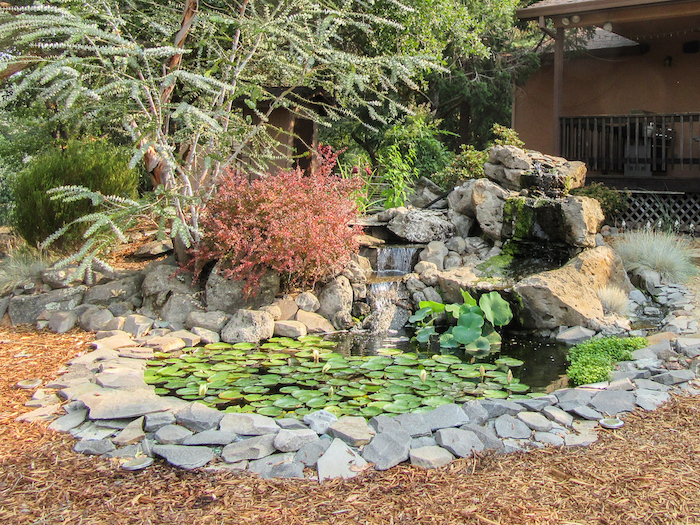
Birds can be attracted to your home simply by offering food, water and shelter. Trees and shrubs that yield fruit, berries, seeds, nuts and cones will provide food. Birdbaths or pools can be built to supply water, and feeders strategically placed around the yard will furnish supplementary food for the birds when natural sources diminish. Tangles of wild plants and dense undergrowth left to thrive in chosen areas of your property will provide shelter, protection, and natural nesting and roosting sites.

Some 84 species of North American birds, excavate nesting holes, use cavities resulting from decay (natural cavities), or use holes created by other species in dead or deteriorating trees for nesting. Many species of these cavity nesting birds have declined because of habitat reduction. But you can help.

Several of the birds that nest in cavities tend to be resident (non-migrating) species and thus more amenable to local habitat management practices than migratory species. Bird houses have been readily accepted by many natural cavity nesters, and increases in breeding density have resulted from providing such structures.

There are probably as many birdhouse plans as there are cavity nesting birds. The important thing is to choose a nest box plan for the species you want to attract that can be opened and cleaned out when necessary. The photo above shows my favorite style birdhouse with a 1 1/2 inch entrance hole. It has been home to Oak Titmouse, Western Bluebird, Violet-green Swallow, Tree Swallow, White-breasted Nuthatch, House Wren, and Ash-throated Flycatcher where I live. I have made one improvement to this design by altering the side door to open from the top rather than the bottom. This allows you to check on the nestlings from the top without opening the door all the way. Here is a nest box specifications chart and several nest box plans.

I cannot emphasize the importance of monitoring any nest box you may place in your yard, or anywhere else for that matter. There are three prime objectives for monitoring nestboxes. First and foremost, with regular, frequent visits to each nestbox, you may be able to spot problems threatening your tenants. You may be able to intervene so as to protect the adults and increase the nestlings’ chances for survival. Second, you can develop a body of knowledge about the habits of cavity-nesters. Lastly, you will build a dated record of each visit to the nestbox that will remind you of the age of the nestlings in the box you are approaching, and what’s been going on at the box during the previous weeks. This record will help you understand and interpret the present visit. And the best reason to monitor your nest box – it’s fun!

One of the most important aspects of nest box monitoring is cleaning out the box after each nesting. RIGHT NOW, before nesting season begins, all nest boxes should be checked to make sure they are clean and ready for occupancy. Your nest boxes should have been cleaned out back in August, after the last completed nesting of whatever species used them. Since then, it is likely that those nest boxes have been used as places to roost during cold weather, accumulating bird droppings. Below is a typical dirty box that has been used as a roost.

This is an American Kestrel box that has never been used. I recently checked it and found a wasp nest inside. They are usually attached to the roof on the inside of the box. Birds won’t use a box with wasps inside. If you find a wasp nest in your nest box, use a thin spatula and crush the wasp nest against the roof of the box. If you don’t kill the adult wasp, she will soon return and rebuild. Keep checking to make sure the wasps don’t return.

This is a nest box that was used by Tree Swallows. This one apparently had two successful nestlings but wasn’t cleaned out between them. You can see the two distinct flattened nests stacked on top of each other bringing any new nesting attempt closer to the entrance hole and therefore easier for a predator to reach eggs or nestlings.

This is a great time to check and clean any birdhouses you have. It’s also the perfect time to repair any damaged boxes and get them ready for the new season before the birds arrive. Believe it or not, birds like a clean house, just like you and I!
If you are interested in monitoring nestboxes for Shasta Birding Society this upcoming season, contact Larry Jordan at webmaster@shastabirdingsociety.org
The Great Backyard Bird Count

This is so easy, anyone could do it! Spend time in your favorite places watching birds, then tell us about them! In as little as 15 minutes notice the birds around you. Identify them, count them, and submit them to help scientists better understand and protect birds around the world. If you already use eBird or Merlin, your submissions over the 4 days count towards GBBC.
How to Participate

Participating is easy, fun to do alone or with others, and can be done anywhere you find birds.
Step 1: Decide where you will watch birds.
Step 2: Watch birds for 15 minutes or more, at least once over the four days, February 16–19, 2024.
Step 3: Identify all the birds you see or hear within your planned time/location and use the best tool for sharing your bird sightings:
- If you are a beginning bird admirer and new to bird identification, try using the Merlin Bird ID app to tell us what birds you are seeing or hearing.
- If you have participated in the count before and want to record numbers of birds, try the eBird Mobile app or enter your bird list on the eBird website (desktop/laptop).
If you already contribute to Merlin or eBird, continue what you are doing! All entries over the 4-days count towards GBBC.
For more information, go to https://www.birdcount.org/
The North American Model of Wildlife Conservation and Who Pays for It

The North American Model of Wildlife Conservation (NAMWC) is often held up as the best system of wildlife management and conservation in the world. Developed in the post-frontier era, the NAMWC helped put a stop to wanton wildlife destruction in an era where many species were being hunted and trapped ruthlessly to the brink of extinction.
But the tenets of the North American Model were developed in the 19th century, when wildlife ethics and science were a mere glimmer of what we understand today. The system was intended as a hunter-centric model, both guided by and benefitting consumptive interests.
Now, in 21st century America, we’re entertaining new considerations, in keeping with our modern understanding of wild animals and conservation. There is:
- Growing skepticism about how well the North American Model serves not just the wild animals in our public trust, but also the conservation priorities of non-consumptive users who are the majority users of public lands.
- Increased scrutiny of practices long considered the norm in wildlife management, including predator hunts, commercial trapping, the legal culling of non-game birds like American Crows, and some of the research protocols used to track and translocate wild animals.
- A new willingness among scientists to consider certain moral and ethical implications with respect to wild animals, where previously utilitarian ideas prevailed, including ideas of intrinsic value.
- Serious examination of the national funding paradigm and how it contributes to the conservation choices made on both federal and state levels.
New Ideas In Conservation
Thomas Serfass, a professor at Maryland’s Frostburg State University says, “I would describe the North American Model as incomplete. Federal funding has never been a prominent part of what’s been, or at least what’s been portrayed (as) the North American Model. Setting land aside in the public domain in perpetuity is probably the most substantive thing we do for wildlife conservation.1”
George Wuerthner, an ecologist and former hunting guide with a degree in wildlife biology, takes the debate a step further. In his piece on state agencies, The North American Model of Wildlife Conservation and Wolves, Mr. Wuerthner states, “Perhaps the most significant and obvious conflict between the goals of the NAMWC and actual behavior of state agencies has to do with management of predators, particularly bears, cougars, coyotes and wolves. State wildlife agencies have a financial conflict of interest that makes it impossible for them to manage predators with regards to the wider public values.”
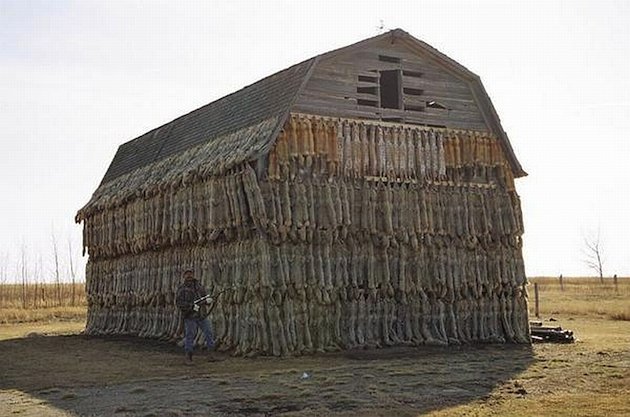
This leads to obvious conflicts with the NAMWC prohibition against the frivolous killing and waste of wildlife. Given that few hunters actually consume coyotes, wolves, cougars, and except for a few individuals, even bears, it is obviously a “waste” of wildlife to shoot or trap these animals just for “fun”2.
Professor Marc Bekoff at the University of Colorado advances the even more progressive idea of “compassionate conservation.” Compassionate conservation describes an emerging field of interest which Bekoff describes in his book Rewilding Our Hearts:
“Compassionate conservation has become a popular new phrase and mind-set over the past few years, one that has increasingly informed global efforts to conserve species and restore ecosystems. Compassionate conservation’s central premise is that every individual animal’s life counts, so our attempts to repair ecological damage or save a certain species, shouldn’t, by design or accident, sacrifice or negatively impact even more life in the process.”
In Coyotes, Compassionate Conservation and Coexistence, Camilla Fox, founder of Project Coyote, echoes this perspective as it relates to predators: “Greater understanding of the ecological importance of native carnivores and increasing public opposition to lethal ‘control’ have led to a growing demand for humane and ecologically sound conservation practices.”
These voices come together on the central point that the North American Model is falling short in critical ways, that it’s outdated when juxtaposed against more progressive ideas in conservation, and that it’s time to seriously consider the shortcomings of our current paradigm while pushing for positive changes that can inform wildlife conservation decisions into the next century.
A significant part of that transformation is recognizing the substantive blocks to change. And among the most important factors is funding and how the funding apparatus is tilted toward preserving the status quo.
As George Wuerthner says with respect to predator control, “In most cases hunters perceive predators as detrimental to hunting—even though there is plenty of evidence that predators seldom depress wildlife populations across the broader landscape. As a result of the funding mechanisms whereby state agencies rely on hunter purchase of hunting tags to maintain operations, these bureaucracies are not going to promote predators in the face of opposition from hunters.”
Consumptive & Non-consumptive Users
Non-consumptive users are accustomed to hearing that conservationist hunters not only fund wildlife endeavors but were also the primaries in early North American conservation efforts. For example, Theodore Roosevelt’s environmental victories are often cited without comparable mention of non-hunter John Muir’s critical influence over Roosevelt’s thinking on ecology, wildlife and environment. As such, non-consumptive users have historically been viewed as lesser stakeholders in wildlife management decisions.
But is there validity to these commonly held ideas?
Michael P. Nelson, a Professor of environmental philosophy and ethics at Oregon State University, points out that recreational hunting was only one of several important factors that led to improved conservation in North America. He notes that “Beginning in the 1960s, for example, conservation was dominated by non-hunters whose legacy includes key legislation such as the U.S. Wilderness Act, Endangered Species Act, Clean Air and Water Acts, and similar acts in Canada. In addition, what are commonly referred to as “non-consumptive” uses of nature—such as national park visitation and bird watching—have also been important for motivating conservation action. These perspectives on the history of conservation do not stand in opposition to hunting, yet they show how other forces also shaped North American wildlife conservation, and how hunting is not necessary for conservation3.

A new study authored by Mark E. Smith and Donald A. Molde, shows that approximately 95% of federal, 88% of non-profit, and 94% of total funding for wildlife conservation and management come from the non-hunting public. The authors contend that a proper understanding and accurate public perception of this funding question is a necessary next step in furthering the current debate as to whether and how much influence the general public should have at the wildlife policy-making level, particularly within state wildlife agencies4.
Smith and Molde state that “Sportsmen favor the current system, which places a heavy emphasis on their interests through favorable composition of wildlife commissions and a continued emphasis on ungulate management.” They agree with George Wuerthner saying, “Nonhuman predators (wolves, mountain lions, coyotes, ravens and others) are disfavored by wildlife managers at all levels as competition for sportsmen and are treated as second-class citizens of the animal kingdom. Sportsmen suggest this bias is justified because ‘Sportsmen pay for wildlife,’ a refrain heard repeatedly when these matters are discussed. Agency personnel and policy foster this belief as well.”
“Funding of wildlife land gets a lot of attention among both sportsmen and other outdoor enthusiasts. Considering the four main federal agencies, the combined state-owned lands, and the collective non profits falling in the category of land trusts, there are 1.038 billion acres of wildlife habitat under conservation management, of which about 4.9% were funded by hunters and 95.1% funded by the non-hunting public.”

The Public Trust Doctrine (PTD) is the principle that certain resources are preserved for public use, and that the government is required to maintain them for the public’s reasonable use. Modern wildlife management has wandered far from the original path of this doctrine and the NAMWC from which it flows. Felix E. Smith, a veteran fish and wildlife biologist, identified three criteria that need to be met for the PTD to be effective:
- The general public must be aware of their legal standing with respect to public ownership of wildlife
- This standing and the rights associated with it must be enforceable against the government so that the public can hold it accountable
- Interpretation of these rights must be adaptable to contemporary concerns, such as biodiversity and species extinction.
All three are impaired when the basis of public debate is a myth. It’s time that we call for honest dialog from our state and federal agencies and transparency in wildlife policy making.
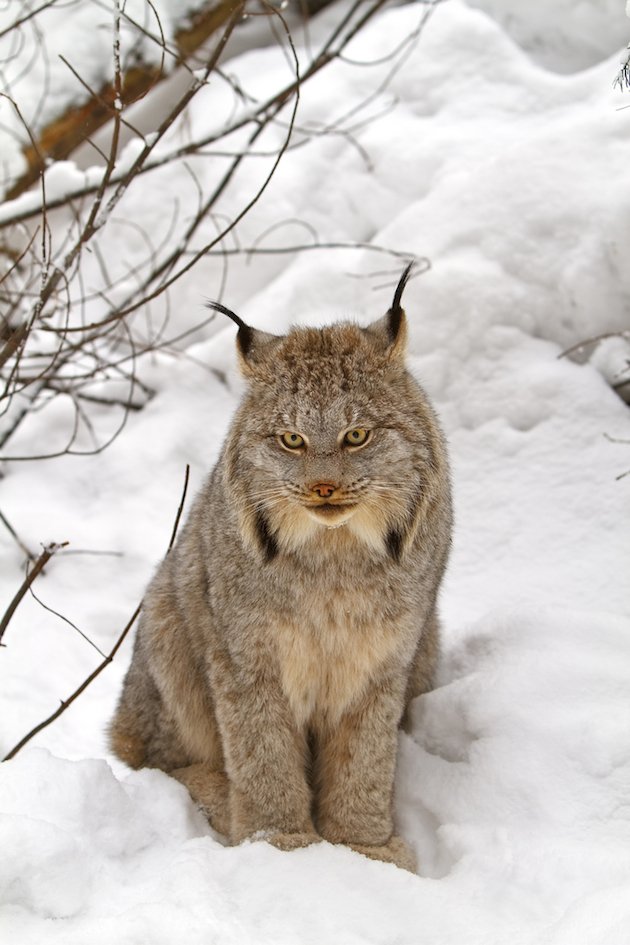
There is a new movement to reinvent wildlife conservation in the 21st century for sustainability. Dr. David Lavigne, Science Advisor to the International Fund for Animal Welfare, co-authored Gaining Ground: In Pursuit of Ecological Sustainability5. He puts forward these Principles of Wildlife Conservation for the 21st Century:
- Wildlife has aesthetic, cultural, ecological, economic, intrinsic, recreational, scientific, social, and spiritual values that need to be acknowledged, preserved and passed on to future generations.
- Recognizing that wildlife has intrinsic value broadens conservation to include both individual animals and the populations they comprise. In other words, 21st century “geocentric” conservation must be concerned about the welfare of individual animals (traditionally termed animal welfare, or animal protection) and the welfare of wild populations (the traditional focus of progressive conservation).
- As a consequence, “people should treat all creatures decently, and protect them from cruelty, avoidable suffering, and unnecessary killing.” This principle reaffirms that animal welfare is an integral part of modern conservation.
- Conservation measures that compromise the welfare of individual animals to achieve goals at the level of the population should not be the preferred means of addressing wildlife conservation issues.
- Capturing wild animals for live trade and captivity should not be permitted. Bringing individual wild animals into captivity for short periods may be permitted, however, to deal with animal welfare issues such as disease, injury or estrangement.
- All attempts to domesticate wild animals should be discouraged.
- Efforts to protect and conserve wildlife and wildlife habitat should begin long before species become rare and more costly to protect.
- The maintenance of viable wildlife populations and functioning ecosystems should take precedence over their use by people.
- Recreational and other uses of wilderness must not compromise the very essence of “wilderness” as untrammeled wild lands, and any such uses should be compatible with this basic principle.
- Wildlife belongs to everyone and no one. It is protected and held in trust for society by governments or appropriate intergovernmental conventions (i.e. central management authorities at an appropriate scale).
- “Highly migratory species” belong to all nations and not just those that wish to exploit them.
- Effective conservation of wildlife relies upon a well-informed and involved public.
- Any material benefits derived from wildlife must be allocated by law – following consultation with the public, who collectively “own” the resource – and not by the marketplace, birthright, land ownership, or social position.
- All individuals share the costs of conserving wildlife. Those whose actions result in additional costs should bear them.
- The onus must be on those who wish to use nature and natural resources, e.g. exploiters and developers, to demonstrate that their actions will not be detrimental to the goal of achieving biological and ecological sustainability.
- The exploiter/developer pays. Those exploiting wildlife should bear the full costs of ensuring that any exploitation is ecologically sustainable, including the cost of enforcing any catch limits, and any scientific research
required to determine those catch limits. Exploitation (and depletion) of wild living resources should no longer be subsidized by governments. - The use of wildlife for subsistence purposes by human populations should not be equated with their commercial consumptive use.
- Use of wildlife and ecosystems should be frugal (parsimonious) and efficient (not wasteful), ensuring that any use is biologically and ecologically sustainable. (Parsimonious use means taking as little as you need, rather than as much as deemed possible as implied, for example, by the idea of maximum sustainable yield.)
- Human development should not threaten the integrity of nature or the survival of other species.
- Development of one society or generation should not limit the opportunities of other societies or generations.
- Each generation should leave to the future a world that is at least as biologically and ecologically diverse and productive as the one it inherited, and – given the current state of the planet – a world in which the physical environment (including the land, water, and atmosphere) is less polluted than the one it inherited.
- The establishment of protected areas – where human impacts, including exploitation and development, on wildlife and their habitats are reduced to an absolute minimum – is an essential component of any plan to achieve biological and ecological sustainability.
- Ultimately, human use of nature must be guided by humility, prudence, and precaution.
The fathers of the conservation movement – including Gifford Pinchot and Aldo Leopold – have been dead now for more than 50 years. The conservation and environmental movements to which they contributed so much have been losing ground for the past 30. Dr. Lavigne concludes that to bring about the future, all conservationists should aspire to necessitate the creation of a New Conservation Movement, dedicated to gaining ground in the pursuit of ecological sustainability, and focused on the acquisition and use of political power to achieve it.
###
The North American Model of Wildlife Conservation is composed of seven focal points:
- Wildlife as Public Trust Resources – Wildlife is a public trust and must be managed for all citizens. No one can “own” wildlife
- Elimination of Markets for Game – Commercial hunting of wildlife is prohibited (but not trapping which is one of the obvious contradictions in the model)
- Allocation of Wildlife by Law – Public participation is essential in development of wildlife management policies
- Wildlife Should Only be Killed for a Legitimate Purpose – A philosophical and legal ban on wasteful and frivolous killing of wildlife
- Wildlife Are Considered an International Resource – As wildlife do not exist only within fixed political boundaries, effective management of these resources must be done internationally
- Science is the Proper Tool for Discharge of Wildlife Policy – Wildlife must be managed using fact, science and the latest research
- Democracy of Hunting – The right to hunt in the United States and Canada by all citizens of good standing
References: 1Wyofile “Study: Non-hunters Contribute Most to Wildlife”, 2North American Model of Wildlife Conservation And Wolves, 3An Inadequate Construct? North American Model: What’s Flawed, What’s Missing, What’s Needed , 4Wildlife Conservation & Management Funding in the U.S., 5Gaining Ground: In Pursuit of Ecological Sustainability
